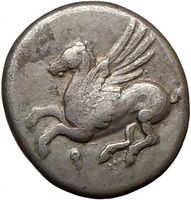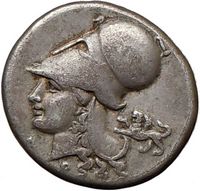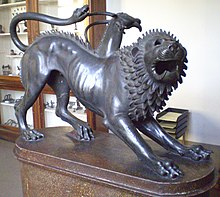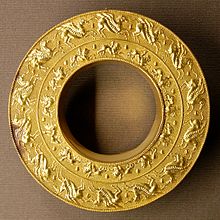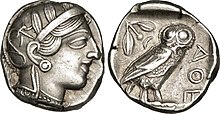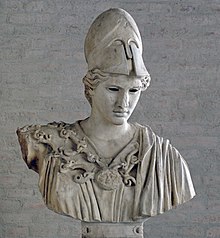|
Greek city of Corinth in Corinthia
Silver Stater 21mm (8.31 grams) Struck circa 400-350 B.C.
Reference: Sear 2626 var.
Pegasus, with pointed wing, flying left; koppa beneath.
Helmeted head of Athena right; behind, facing
Chimera.
The Corinth mint was active throughout the 5th and 4th
Centuries, except for for periods during the Peloponnesian War, when her hostile
attitude toward Athens may have restricted her supply of silver bullion. The
output of staters and drachms increased dramatically in the second half of the
4th Century, probably in connection with Timoleon's successful intervention in
Sicilian affairs, commencing 344 B.C. Corinth was occupied by the forces
of Ptolemy I of Egypt from 308-306 B.C., and her silver coinage ceased soon
after. She joined the Achaean League in the 3rd Century, but later opposed Rome
and was utterly destroyed by the consul L. Mummius in 146 B.C.
You are bidding on the exact
item pictured, provided with a Certificate of Authenticity and Lifetime
Guarantee of Authenticity.
The Chimera was, according to
Greek mythology, a monstrous fire-breathing
female and male creature of
Lycia in
Asia Minor, composed of the parts of three
animals — a
lion, a
snake and a
goat. Usually depicted as a lion, with the head of a goat arising
from its back, and a tail that ended in a snake's head, the Chimera was one of
the offspring of
Typhon and
Echidna and a sibling of such monsters as
Cerberus and the
Lernaean Hydra.

The term chimera has come to describe any mythical or fictional animal with
parts taken from various animals, or to describe anything perceived as wildly
imaginative or implausible.
Description
Homer's brief description in the
Iliad is the earliest surviving literary
reference: "a thing of immortal make, not human, lion-fronted and snake behind,
a goat in the middle, and snorting out the breath of the terrible flame of
bright fire". Elsewhere in the Iliad, Homer attributes the rearing of
Chimera to Amisodorus.
Hesiod's
Theogony follows the Homeric description:
he makes the Chimera the issue of
Echidna: "She was the mother of Chimaera who
breathed raging fire, a creature fearful, great, swift-footed and strong, who
had three heads, one of a grim-eyed
lion; in her hinderpart, a
dragon; and in her middle, a
goat, breathing forth a fearful blast of blazing fire. Her did
Pegasus and noble Bellerophon slay" The author of the
Bibliotheca concurs: descriptions agree
that she breathed
fire. The Chimera is generally considered to
have been female (see the quotation from Hesiod above) despite the
mane adorning its
lion's head, the inclusion of a close mane often was depicted on
lionesses, but the ears always were visible (that does not occur with depictions
of male lions). Sighting the Chimera was an omen of
storms,
shipwrecks, and
natural disasters (particularly
volcanoes).
While there are different
genealogies, in one version the Chimera mated
with her brother
Orthrus and mothered the
Sphinx and the
Nemean lion (others have Orthrus and their
mother, Echidna, mating; most attribute all to Typhon and Echidna).
The Chimera finally was defeated by
Bellerophon, with the help of
Pegasus, at the command of
King Iobates of
Lycia. Since Pegasus could fly, Bellerophon
shot the Chimera from the air, safe from her heads and breath. A
scholiast to Homer adds that he finished her
off by equipping his spear with a lump of lead that melted when exposed to the
Chimera's fiery breath and consequently killed her, an image drawn from
metalworking.
Robert Graves suggests,[10]
"The Chimera was, apparently, a calendar-symbol of the tripartite year, of which
the seasonal emblems were lion, goat, and serpent."

Pebble mosaic depicting Bellerophon killing the Chimera, from
Rhodes archaeological museum
The Chimera was situated in foreign Lycia, but her representation in the arts
was wholly Greek. An autonomous tradition, one that did not rely on the written
word, was represented in the visual repertory of the Greek vase-painters. The
Chimera first appears at an early stage in the
proto-Corinthian pottery-painters' repertory,
providing some of the earliest identifiable mythological scenes that can be
recognized in
Greek art. The Corinthian type is fixed, after
some early hesitation, in the 670s BC; the variations in the pictorial
representations suggest to Marilyn Low Schmitt a multiple origin. The
fascination with the monstrous devolved by the end of the seventh century into a
decorative Chimera-motif in Corinth, while the motif of Bellerophon on Pegasus
took on a separate existence alone. A separate Attic tradition, where the goats
breathe fire and the animal's rear is serpent-like, begins with such confidence
that Marilyn Low Schmitt is convinced there must be unrecognized earlier local
prototypes. Two vase-painters employed the motif so consistently they are given
the pseudonyms the Bellerophon Painter and the Chimaera Painter. A
fire-breathing lioness was one of the earliest of solar and war deities in
Ancient Egypt (representations from 3000 years prior to the Greek) and
influences are feasible.
In
Etruscan civilization, the Chimera appears in
the "Orientalizing" period that precedes Etruscan Archaic art; that is to say,
very early indeed. The Chimera appears in Etruscan wall-paintings of the fourth
century BC.
In
Medieval art, though the Chimera of Antiquity
was forgotten, chimerical figures appear as embodiments of the deceptive, even
Satanic forces of raw nature. Provided with a
human face and a scaly tail, as in
Dante's vision of
Geryon in
Inferno xvii.7–17, 25–27, hybrid monsters,
more akin to the
Manticore of
Pliny's Natural History (viii.90), provided
iconic representations of hypocrisy and fraud well into the seventeenth century,
through an emblemmatic representation in
Cesare Ripa's Iconologia.
Classical sources
The myths of the Chimera can be found in
Pseudo-Apollodorus'
Bibliotheca (book 1),
Homer's
Iliad (book 6);
Hyginus' Fabulae 57 and 151;
Ovid's
Metamorphoses (book VI 339; IX 648); and
Hesiod's
Theogony 319ff.
Virgil, in the
Aeneid (book 5) employs Chimaera for
the name of
Gyas' gigantic ship in the ship-race, with
possible allegorical significance in contemporary Roman politics.
Hypothesis about
origin

The eternal fires of
Chimera in
Lycia, modern-day Turkey, where the
myth takes place
Main article:
Mount Chimaera
Pliny the Elder cited
Ctesias and quoted
Photius identifying the Chimera with an area of
permanent gas vents which still can be found today by hikers on the
Lycian Way in southwest
Turkey. Called in Turkish
Yanartaş (flaming rock), it consists of
some two dozen vents in the ground, grouped in two patches on the hillside above
the Temple of
Hephaestus about 3 km north of
Çıralı, near ancient
Olympos, in
Lycia. The vents emit burning
methane thought to be of
metamorphic origin, which in ancient times were
landmarks by which sailors could navigate.
The Neo-Hittite Chimera from
Carchemish, dated to 850–750 BC, which is now
housed in the
Museum of Anatolian Civilizations no doubt
served as a basis for the Greek legend. It differs from the Greek version in
that while there are three heads, none of them is that of a goat, only a main
human head, a lion's head facing forward and placed on the chest of the lion's
body, and a snake's head placed at the end of the tail.
Use
for Chinese mythological creatures
Some western scholars of Chinese art, starting with
Victor Segalen, use the word "chimera"
generically to refer to winged quadrupeds, such as
bixie,
tianlu, and even
qilin.
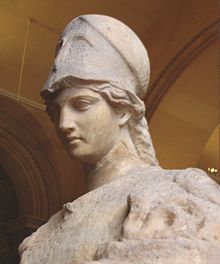
Helmeted Athena with the cista and Erichthonius in his serpent form.
Roman, first century ( Louvre
Museum) In
Greek religion and
mythology, Athena or Athene, also
referred to as Pallas Athena/Athene , is the goddess of wisdom, courage,
inspiration, civilization, law and justice, just warfare, mathematics, strength,
strategy, the arts, crafts, and skill.
Minerva is the
Roman goddess
identified with Athena.
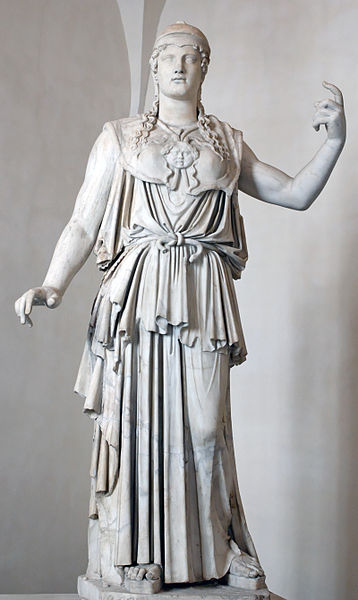
Marble Greek copy signed "Antiokhos", a first century BC variant of
Phidias'
fifth-century
Athena Promachos
that stood on the
Acropolis
Athena is also a shrewd companion of
heroes and is the
goddess of heroic endeavour. She is the
virgin patroness of
Athens. The Athenians founded the
Parthenon on the Acropolis of her namesake
city, Athens (Athena Parthenos), in her honour.
Athena's veneration as the patron of Athens seems to have existed from the
earliest times, and was so persistent that archaic myths about her were recast
to adapt to cultural changes. In her role as a protector of the city (polis),
many people throughout the Greek world worshiped Athena as Athena Polias
(Ἀθηνᾶ Πολιά�‚ "Athena of the city"). The city of
Athens and the goddess Athena essentially bear
the same name,
"Athenai" meaning "[many] Athenas".
Origin traditions
The Greek philosopher
Plato (429–347 BC) identified her with the
Libyan deity
Neith, the war goddess and huntress deity of the
Egyptians since the ancient Pre-Dynastic period, who was also identified with
weaving. This is sensible, as some Greeks
identified Athena's birthplace, in certain mythological renditions, as being
beside Libya's Triton River in North Africa.
Scholar
Martin Bernal created the controversial
Black Athena Theory to explain this associated
origin by claiming that the conception of
Neith was brought to Greece from Egypt, along
with "an enormous number of features of civilization and culture in the third
and second millennia."
Patroness
Athena as the goddess of philosophy became an aspect of the cult in Classical
Greece during the late 5th century BC.She is the patroness of various crafts, especially of
weaving, as Athena Ergane, and was
honored as such at festivals such as
Chalceia. The metalwork of weapons also fell
under her patronage. She led battles (Athena
Promachos or the warrior maiden Athena Parthenos)
as the disciplined, strategic side of war, in contrast to her brother
Ares, the patron of violence, bloodlust and slaughter�"the raw force
of war".
Athena's wisdom includes the cunning intelligence (metis) of such figures
as
Odysseus. Not only was this version of Athena
the opposite of Ares in combat, it was also the polar opposite of the serene
earth goddess version of the deity, Athena Polias.
Athena appears in Greek mythology as the patron and helper of many heroes,
including
Odysseus,
Jason, and
Heracles. In
Classical Greek myths, she never consorts with
a lover, nor does she ever marry,earning the title Athena Parthenos. A remnant of archaic myth depicts her
as the adoptive mother of
Erechtheus/Erichthonius
through the foiled rape by
Hephaestus.
Other variants relate that Erichthonius, the serpent that accompanied Athena,
was born to
Gaia: when the rape failed, the semen landed on
Gaia and impregnated her. After Erechthonius was born, Gaia gave him to Athena.
Though Athena is a goddess of war strategy, she disliked fighting
without
purpose and preferred to use wisdom to settle predicaments.The goddess
only encouraged fighting for a reasonable cause or to resolve
conflict. As patron of Athens she fought in the Trojan war on the side
of the
Achaeans.
Mythology
Birth
Olympian version
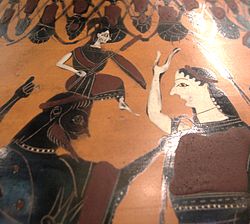
After he swallowed her pregnant mother,
Metis, Athena is "born" from Zeus'
forehead as he grasps the clothing of
Eileithyia on the right � black-figured
amphora, 550–525 BC, Louvre.
Although Athena appears before
Zeus at
Knossos �in
Linear B, as,
"Mistress Athena"�in
the Classical
Olympian pantheon, Athena was remade as the
favorite daughter of Zeus, born fully armed from his forehead.
The story of her birth comes in several versions. In the one most commonly
cited, Zeus lay with Metis, the goddess of crafty thought and wisdom, but he
immediately feared the consequences. It had been prophesied that Metis would
bear children more powerful than the sire,
even Zeus himself. In order to forestall these dire consequences, after lying
with Metis, Zeus "put her away inside his own belly;" he "swallowed her down all
of a sudden."
He was too late: Metis had already conceived.
Eventually Zeus experienced an enormous headache;
Prometheus,
Hephaestus,
Hermes,
Ares, or Palaemon (depending on the sources examined) cleaved Zeus's
head with the double-headed
Minoan
axe,
the
labrys. Athena leaped from Zeus's head,
fully grown and armed, with a shout� "and pealed to the broad sky her clarion
cry of war. And Ouranos trembled to hear, and Mother Gaia..." (Pindar,
Seventh Olympian Ode). Plato, in the
Laws, attributes the cult of Athena to the
culture of
Crete, introduced, he thought, from Libya
during the dawn of Greek culture.
Classical myths thereafter note that
Hera was so annoyed at Zeus for having produced a child that she
conceived and bore
Hephaestus by
herself.
Plato, in
Cratylus (407B) gave the etymology of her
name as signifying "the mind of god", theou noesis. The Christian
apologist of the 2nd century
Justin Martyr takes issue with those pagans who
erect at springs images of
Kore, whom he interprets as Athena:
"They said that Athena was the daughter of Zeus not from intercourse, but
when the god had in mind the making of a world through a word (logos)
his first thought was Athena".
Other origin tales
Some origin stories tell of Athena having been born outside of Olympus and
raised by the god Triton. Fragments attributed by the Christian
Eusebius of Caesarea to the semi-legendary
Phoenician historian
Sanchuniathon, which Eusebius thought had been
written before the
Trojan war, make Athena instead the daughter of
Cronus, a king of
Byblos who visited 'the inhabitable world' and
bequeathed
Attica to Athena.
Sanchuniathon's account would make Athena the sister of Zeus and Hera, not Zeus'
daughter.
Pallas Athena
The major competing tradition regarding Athena's parentage involves some of
her more mysterious
epithets: Pallas, as in the ancient-Greek
Παλλά�‚ Άθήνη (also Pallantias) and
Tritogeneia (also Trito, Tritonis, Tritoneia, Tritogenes). A distant archaic
separate entity named
Pallas is invoked as Athena's father, sister,
foster sister, companion, or opponent in battle. Pallas is often a nymph, a
daughter of
Triton (a sea god), and a childhood friend of
Athena.
In every case, Athena kills Pallas, accidentally, and thereby gains the name
for herself. In one telling, they practice the arts of war together until one
day they have a falling out. As Pallas is about to strike Athena, Zeus
intervenes. With Pallas stunned by a blow from Zeus, Athena takes advantage and
kills her. Distraught over what she has done, Athena takes the name Pallas for
herself.
When Pallas is Athena's father the events, including her birth, are located
near a body of water named Triton or
Tritonis. When Pallas is Athena's sister or
foster-sister, Athena's father or foster-father is
Triton, the son and herald of
Poseidon. But Athena may be called the daughter
of Poseidon and a nymph named Tritonis, without involving Pallas. Likewise,
Pallas may be Athena's father or opponent, without involving Triton.
On this topic, Walter Burkert says "she is the Pallas of Athens, Pallas
Athenaie, just as Hera of Argos is Here Argeie.
For the Athenians, Burkert notes, Athena was simply "the Goddess", hē theós,
certainly an ancient title.
Athena
Parthenos: Virgin Athena
Athena never had a consort or lover and is thus known as
Athena Parthenos, "Virgin Athena". Her most
famous temple, the
Parthenon, on the
Acropolis in
Athens takes its name from this title. It is
not merely an observation of her virginity, but a recognition of her role as
enforcer of rules of sexual modesty and ritual mystery. Even beyond recognition,
the Athenians allotted the goddess value based on this pureness of virginity as
it upheld a rudiment of female behavior in the patriarchal society. Kerenyi's
study and theory of Athena accredits her virginal toponym to be a result of the
relationship to her father Zeus and a vital, cohesive piece of her character
throughout the ages.
This role is expressed in a number of stories about Athena.
Marinus of Neapolis reports that when
Christians removed the statue of the Goddess from the
Parthenon, a beautiful woman appeared in a
dream to
Proclus, a devotee of Athena, and announced
that the "Athenian Lady" wished to dwell with him.
Erichthonius
Hephaestus attempted to
rape Athena, but she eluded him. His
semen fell to the earth and impregnated the
soil, and
Erichthonius was born from the Earth,
Gaia. Athena then raised the baby as a foster
mother.
Athena puts the infant Erichthonius into a small box (cista) which she
entrusts to the care of three sisters,
Herse,
Pandrosus, and
Aglaulus of Athens. The goddess does not tell
them what the box contains, but warns them not to open it until she returns. One
or two sisters opens the cista to reveal Erichthonius, in the form (or
embrace) of a
serpent. The serpent, or insanity induced by
the sight, drives Herse and Aglaulus to throw themselves off the
Acropolis.
Jane Harrison (Prolegomena) finds this to be a simple cautionary tale
directed at young girls carrying the cista in the
Thesmophoria rituals, to discourage them from
opening it outside the proper context.
Another version of the myth of the Athenian maidens is told in
Metamorphoses by the Roman poet
Ovid (43 BC – 17 AD); in this late variant
Hermes falls in love with Herse. Herse,
Aglaulus, and Pandrosus go to the temple to offer sacrifices to Athena. Hermes
demands help from Aglaulus to seduce Herse. Aglaulus demands money in exchange.
Hermes gives her the money the sisters have already offered to Athena. As
punishment for Aglaulus's greed, Athena asks the goddess
Envy to make Aglaulus jealous of Herse. When
Hermes arrives to seduce Herse, Aglaulus stands in his way instead of helping
him as she had agreed. He turns her to stone.
With this mythic origin, Erichthonius became the founder-king
of Athens, and many beneficial changes to Athenian culture were
ascribed to him. During this time, Athena frequently protected him.
Medusa and Tiresias
In a late myth,
Medusa, unlike her sister Gorgons, came
to be
viewed by the Greeks of the 5th century as a beautiful mortal that
served as
priestess in Athena's temple. Poseidon liked Medusa, and decided to rape
her in
the temple of Athena, refusing to allow her vow of chastity to stand in
his way.Upon discovering the desecration of her temple, Athena changed
Medusa's form to
match that of her sister Gorgons as punishment. Medusa's hair turned
into
snakes, her lower body was transformed also, and meeting her gaze would
turn any
living man to stone. In the earliest myths, there is only one
Gorgon, but there are two snakes that form a
belt around her waist.
In one version of the
Tiresias myth, Tiresias stumbled upon Athena
bathing, and he was struck blind by her to ensure he would never again see what
man was not intended to see. But having lost his eyesight, he was given a
special gift�to be able to understand the language of the birds (and thus to
foretell the future).
Lady of Athens
Athena competed with
Poseidon to be the patron deity of Athens,
which was yet unnamed, in a version of one
founding myth. They agreed that each would give
the Athenians one gift and that the Athenians would choose the gift they
preferred. Poseidon struck the ground with his
trident and a salt water spring sprang up; this
gave them a means of trade and water�Athens at its height was a significant sea
power, defeating the
Persian fleet at the
Battle of Salamis�but the water was salty and
not very good for drinking.
Athena, however, offered them the first domesticated
olive tree. The Athenians (or their king,
Cecrops) accepted the olive tree and with it
the patronage of Athena, for the olive tree brought wood, oil, and food.
Robert Graves was of the opinion that
"Poseidon's attempts to take possession of certain cities are political myths"
which reflect the conflict between matriarchal and patriarchal religions.
Other sites of cult
Athena also was the patron goddess of several other Greek cities, notably
Sparta, where the archaic cult of
Athena Alea had its sanctuaries in the
surrounding villages of
Mantineia and, notably,
Tegea. In Sparta itself, the temple of Athena
KhalkÃÂoikos (Athena "of the Brazen House", often
latinized as Chalcioecus) was the
grandest and located on the Spartan acropolis; presumably it had a roof of
bronze. The forecourt of the Brazen House was the place where the most solemn
religious functions in Sparta took place.
Tegea was an important religious center of ancient Greece,
containing the Temple of
Athena Alea. The temenos was founded by
Aleus,
Pausanias was informed.
Votive bronzes at the site from the Geometric and Archaic periods take the forms
of horses and deer; there are
sealstone and
fibulae. In the Archaic period the nine
villages that underlie Tegea banded together in a
synoecism to form one city.
Tegea was listed in
Homer's
Catalogue of Ships as one of the cities that
contributed ships and men for the
Achaean assault on Troy.
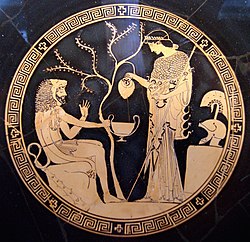
Athena and Herakles on an
Attic red-figure
kylix, 480–470 BC.
Counselor
Later myths of the Classical Greeks relate that Athena guided
Perseus in his quest to behead
Medusa. She instructed
Heracles to skin the
Nemean Lion by using its own claws to cut
through its thick hide. She also helped Heracles to defeat the
Stymphalian Birds, and to navigate the
underworld so as to capture
Cerberus.
In
The Odyssey,
Odysseus' cunning and shrewd nature quickly won
Athena's favour. In the realistic epic mode, however, she largely is confined to
aiding him only from afar, as by implanting thoughts in his head during
his journey home from Troy. Her guiding actions reinforce her role as the
"protectress of heroes" or as mythologian
Walter Friedrich Otto dubbed her the "goddess
of nearness" due to her mentoring and motherly probing.
It is not until he washes up on the shore of an island where
Nausicaa is washing her clothes that Athena
arrives personally to provide more tangible assistance. She appears in
Nausicaa's dreams to ensure that the princess rescues Odysseus and plays a role
in his eventual escort to Ithaca.
Athena appears in disguise to Odysseus upon his arrival, initially lying and
telling him that Penelope, his wife, has remarried and that he is believed to be
dead; but Odysseus lies back to her, employing skillful prevarications to
protect himself.
Impressed by his resolve and shrewdness, she reveals herself and tells him what
he needs to know in order to win back his kingdom. She disguises him as an
elderly man or beggar so that he cannot be noticed by the suitors or Penelope,
and helps him to defeat the suitors.
She also plays a role in ending the resultant feud against the suitors'
relatives. She instructs Laertes to throw his spear and to kill the father of
Antinous, Eupeithes.
Judgment of Paris
All the gods and goddesses as well as various mortals were invited to the
marriage of
Peleus and
Thetis (the eventual parents of
Achilles). Only
Eris, goddess of discord, was not invited. She
was annoyed at this, so she arrived with a golden apple inscribed with the word
καλλί�ƒ�„ῃ (kallistÄ“i, "for the fairest"), which she threw among the goddesses.
Aphrodite, Hera, and Athena all claimed to be the fairest, and thus the rightful
owner of the apple.
The goddesses chose to place the matter before Zeus, who, not wanting to
favor one of the goddesses, put the choice into the hands of Paris, a
Trojan prince. After bathing in the spring of
Mount Ida (where Troy was situated), the
goddesses appeared before Paris. The goddesses undressed and presented
themselves to Paris naked, either at his request or for the sake of winning.

Paris is awarding the apple to Aphrodite, while Athena makes a face.
Urteil des Paris by
Anton Raphael Mengs, ca. 1757
Still, Paris could not decide, as all three were ideally beautiful, so they
resorted to bribes. Hera tried to bribe Paris with control over all
Asia and
Europe, while Athena offered wisdom, fame and
glory in battle, but Aphrodite came forth and whispered to Paris that if he were
to choose her as the fairest he would have the most beautiful mortal woman in
the world as a wife, and he accordingly chose her. This woman was
Helen, who was, unfortunately for Paris,
already married to King
Menelaus of
Sparta. The other two goddesses were enraged by
this and through Helen's abduction by Paris they brought about the
Trojan War.
Roman fable of Arachne
The
fable of
Arachne is a late Roman addition to Classical
Greek mythology
but does not appear in the myth repertoire of the Attic vase-painters. Arachne's
name simply means spider (α��ά�‡Î½Î·). Arachne was the daughter of a famous
dyer in
Tyrian purple in Hypaipa of
Lydia, and a weaving student of Athena. She
became so conceited of her skill as a weaver that she began claiming that her
skill was greater than that of Athena herself.
Athena gave Arachne a chance to redeem herself by assuming the form of an old
woman and warning Arachne not to offend the deities. Arachne scoffed and wished
for a weaving contest, so she could prove her skill.
Athena wove the scene of her victory over
Poseidon that had inspired her patronage of
Athens. According to Ovid's Latin narrative, Arachne's tapestry featured
twenty-one episodes of the infidelity of the deities, including
Zeus being unfaithful with
Leda, with
Europa, and with
Danaë. Athena admitted that Arachne's work was
flawless, but was outraged at Arachne's offensive choice of subjects that
displayed the failings and transgressions of the deities. Finally, losing her
temper, Athena destroyed Arachne's tapestry and loom, striking it with her
shuttle.
Athena then struck Arachne with her staff, which changed her into a spider.
In some versions, the destruction of her loom leads Arachne to hang herself in
despair; Athena takes pity on her, and transforms her into a spider. In the
aforementioned version, Arachne weaved scenes of joy while Athena weaved scenes
of horror.
The fable suggests that the origin of weaving lay in imitation of spiders and
that it was considered to have been perfected first in
Asia Minor.
Cult and attributes
In poetry from Homer, an oral tradition of the eighth or seventh century BC,
onward, Athena's most common
epithet is glaukopis (γλα�…κ�Ž�€Î¹�‚), which
usually is translated as, bright-eyed or with gleaming eyes.The word is a combination of glaukos (γλα��κο�‚, meaning gleaming,
silvery, and later, bluish-green or gray) and ops (�Ž�ˆ,
eye, or sometimes, face). It is interesting to note that glaux
(γλα��ξ, "owl") is from the same root, presumably because of the bird's own
distinctive eyes. The bird which sees well in the night is closely associated
with the goddess of
wisdom: in archaic images, Athena is frequently
depicted with an owl named the
Glaucus (or "owl of Athena" and later under the
Roman Empire, "owl of
Minerva") perched on her hand. This pairing
evolved in tangent so that even in present day the owl is upheld as a symbol of
perspicacity and erudition.
Unsurprisingly, the owl became a sort of Athenian mascot. The
olive tree is likewise sacred to her. In
earlier times, Athena may well have been a
bird goddess, similar to the unknown goddess
depicted with owls, wings, and bird talons on the
Burney relief, a Mesopotamian terracotta relief
of the early second millennium BC.
Other epithets include: Aethyta under which she was worshiped in
Megara.
The word aithyia (αἴθ�…ια)
signifies a diver, and figuratively, a ship, so the name must
reference Athena teaching the art of shipbuilding or navigation.In a temple at Phrixa in
Elis, which was reportedly built by Clymenus, she was known as
Cydonia.
The various Athena subgroups, or cults, all branching from the central
goddess herself often proctored various initiation rites of Grecian youth, for
example, the passage into citizenship by young men and for women the elevation
to the status of citizen wife. Her various cults were portals of a uniform
socialization, even beyond mainland Greece.
Epithets
In the
Iliad (4.514), the
Homeric Hymns, and in
Hesiod's
Theogony, Athena is given the curious
epithet Tritogeneia. The meaning of this term is unclear. It seems to
mean "Triton-born",
perhaps indicating that the sea-deity was her parent according to some early
myths.
In Ovid's Metamorphoses Athena is occasionally referred to as "Tritonia".
Another possible meaning may be triple-born or third-born,
which may refer to a triad or to her status as the third daughter of Zeus or the
fact she was born from Metis, Zeus, and herself; various legends list her as
being the first child after Artemis and Apollo, though other legends identify her as Zeus' first child. The
latter would have to be drawn from Classical myths, however, rather than earlier
ones.
In her role as judge at
Orestes' trial on the murder of his mother,
Clytemnestra (which he won), Athena won the
epithet Athena Areia.
Other epithets were
Ageleia and
Itonia.
Athena was given many other cult titles. She has the epithet Athena Ergane
as the patron of craftsmen and artisans. With the epithet
Athena Parthenos ("virgin") she was
especially worshipped in the festivals of the
Panathenaea and
Pamboeotia where both militaristic and athletic
displays took place.With the epithet
Athena Promachos she led in battle (see
Promachos). With the epithet Athena Polias
("of the city"), Athena was the protector of not only Athens but also of many
other cities, including
Argos,
Sparta,
Gortyn,
Lindos, and
Larisa.
She was given the epithet
Athena Hippeia or Athena Hippia
("horse"), as the inventor of the
chariot, and was worshiped under this title at
Athens,
Tegea and
Olympia. As Athena Hippeia she was given an
alternative parentage:
Poseidon and
Polyphe, daughter of
Oceanus.In each of these cities her temple frequently was the major temple on the
acropolis.Athena often was equated with
Aphaea, a local goddess of the island of
Aegina, located near
Athens, once Aegina was under Athenian's power.
The Greek historian
Plutarch (46–120 AD) also refers to an instance
during the Parthenon's construction of her being called Athena
Hygieia ("healer"):
A strange accident happened in the course of building, which showed that
the goddess was not averse to the work, but was aiding and co-operating
to bring it to perfection. One of the artificers, the quickest and the
handiest workman among them all, with a slip of his foot fell down from
a great height, and lay in a miserable condition, the physicians having
no hope of his recovery. When
Pericles was in distress about this,
the goddess [Athena] appeared to him at night in a dream, and ordered a
course of treatment, which he applied, and in a short time and with
great ease cured the man. And upon this occasion it was that he set up a
brass statue of Athena Hygeia, in the citadel near the altar, which they
say was there before. But it was
Phidias who wrought the goddess's image
in gold, and he has his name inscribed on the pedestal as the workman of
it.
In classical times the
Plynteria, or “Feast of Adorning�, was observed
every May, it was a festival lasting five days. During this period the
Priestesses of Athena, or “Plyntrides�, performed a cleansing ritual within “the
Erecththeum�, the personal sanctuary of the goddess. Here Athena's statue was
undressed, her clothes washed, and body purified.
In
Arcadia, she was assimilated with the ancient
goddess Alea and worshiped as
Athena Alea.
In Classical art
Classically, Athena is portrayed wearing a full- length
chiton, and sometimes in armor, with her helmet
raised high on the forehead to reveal the image of
Nike. Her shield bears at its centre the aegis
with the head of the gorgon (gorgoneion) in the center and snakes around the
edge. It is in this standing posture that she was depicted in
Phidias's famous lost
gold and ivory statue of her, 36 m tall, the
Athena Parthenos in the
Parthenon. Athena also often is depicted with
an
owl sitting on one of her shoulders.
The
Mourning Athena is a relief sculpture that
dates around 460 BC and portrays a weary Athena resting on a staff. In earlier,
archaic portraits of Athena in
Black-figure pottery, the goddess retains some
of her Minoan-Mycenaean character, such as great bird wings although this is not
true of archaic sculpture such as those of
Aphaean Athena, where Athena has subsumed an
earlier, invisibly numinous�Aphaea�goddess
with Cretan connections in her mythos.
Other commonly received and repeated types of Athena in sculpture may be
found in
this list.
Apart from her attributes, there seems to be a relative consensus in late
sculpture from the Classical period, the 5th century onward, as to what Athena
looked like. Most noticeable in the face is perhaps the full round strong,
masculine chin with a high nose that has a high bridge as a natural extension of
the forehead. The eyes typically are somewhat deeply set. The unsmiling lips are
usually full, but the mouth is depicted fairly narrow, usually just slightly
wider than the nose. The neck is somewhat long. The net result is a serene,
serious, somewhat aloof, and very masculine beauty.
Name,
etymology, and origin
Athena had a special relationship with
Athens, as is shown by the etymological
connection of the names of the goddess and the city. The citizens of Athens
built a statue of Athena as a temple to the goddess, which had piercing eyes, a
helmet on her head, attired with an
aegis or
cuirass, and an extremely long spear. It also
had a crystal shield with the head of the Gorgon on it. A large snake
accompanied her and she held the goddess of victory in her hand.
Athena is associated with
Athens, a plural name because it was the place
where she presided over her sisterhood, the Athenai, in earliest times:
Mycenae was the city where the Goddess was
called Mykene, and Mycenae is named in the plural for the sisterhood of females
who tended her there. At
Thebes she was called Thebe, and the city again
a plural, Thebae (or Thebes, where the "s" is the plural formation). Similarly,
at Athens she was called Athena, and the city Athenae (or Athens, again a
plural)."Whether her name is attested in
Eteocretan or not will have to wait for
decipherment of
Linear A.
Günther Neumann has suggested that Athena's name is possibly of
Lydian origin;
it may be a compound word derived in part from
Tyrrhenian "ati", meaning mother and the
name of the
Hurrian goddess "Hannahannah"
shortened in various places to "Ana". In
Mycenaean Greek, at
Knossos a single inscription A-ta-na
po-ti-ni-ja /Athana potniya/ appears in the
Linear B tablets from the Late Minoan II-era
"Room of the Chariot Tablets"; these comprise the earliest Linear B archive
anywhere.
Although Athana potniya often is translated Mistress Athena, it
literally means "the potnia of At(h)ana", which perhaps, means the
Lady of Athens;[Any connection to the city of Athens in the Knossos inscription is uncertain.
We also find A-ta-no-dju-wa-ja /Athana diwya/, the final part
being the Linear B spelling of what we know from Ancient Greek as Diwia
: divine Athena also
was a weaver and the deity of crafts (see
dyeus).
In his dialogue
Cratylus, the Greek philosopher
Plato, 428/427 BC – 348/347 BC, gives the
etymology of Athena's name, based on the view of the ancient Athenians:
That is a graver matter, and there, my friend, the modern interpreters
of Homer may, I think, assist in explaining the view of the ancients.
For most of these in their explanations of the poet, assert that he
meant by Athena "mind" [ nous]
and "intelligence" [ dianoia], and the maker of names appears to
have had a singular notion about her; and indeed calls her by a still
higher title, "divine intelligence" [ Theian noesis], as though he
would say: This is she who has the mind better than others. Nor shall we
be far wrong in supposing that the author of it wished to identify this
Goddess with moral intelligence [ en ethei noesin], and therefore
gave her the name etheonoe; which, however, either he or his successors
have altered into what they thought a nicer form, and called her Athena .
�Plato, Cratylus, 407b
Thus for Plato her name was to be derived from Greek Ἀθεον�ŒÎ±, Atheonóaâ€�which
the later Greeks rationalised as from the deity's (theos) mind (nous).
Plato noted that the Egyptian citizens of
Sais in Egypt worshipped a goddess whose
Egyptian name was
Neith;
and they identified her with Athena. (Timaeus
21e), (Histories
2:170–175).
Some authors[citation
needed] believe that, in early times, Athena was
either an
owl herself or a
bird goddess in general: in Book 3 of the
Odyssey, she takes the form of a
sea-eagle. These authors argue that she dropped
her prophylactic owl-mask before she lost her wings. "Athena, by the time she
appears in art," Jane Ellen Harrison had remarked, "has completely shed her
animal form, has reduced the shapes she once wore of snake and bird to
attributes, but occasionally in
black-figure vase-paintings she still appears
with wings."Some Greek authors
have derived natural symbols from the etymological roots of Athena's names to be
aether, air, earth, and moon. This was one of the primary developments of
scholarly exploration in the ancient world.
Post-classical culture
A brief summary of Athena's evolution of myriad motifs after her dominance in
Greece may be seen as follows: The rise of Christianity in Greece largely ended
the worship of Greek deities and polytheism in general, but she resurfaced in
the Middle Ages as a defender of sagacity and virtue so that her masculine
warrior status was still intact. (She may be found on some family crests of
nobility.) During the Renaissance she donned the mantle of patron of the arts
and human endeavor and finally although not ultimately, Athena personified the
miracles of freedom and republic during the French Revolution. (A statue of the
goddess was centered on the Place de la Revolution in Paris.)
For over a century
a full-scale replica of the Parthenon has stood
in
Nashville, Tennessee, which is known as the
Athens of the South. In 1990, a gilded 41 feet (12.5 m) tall
replica of Phidias' statue of Athena Parthenos
was added. The state
seal of California features an image of Athena
(or Minerva) kneeling next to a brown grizzly bear.
Athena is a natural patron of universities: she is the symbol of the
Darmstadt University of Technology, in Germany,
and the
Federal University of Rio de Janeiro, in
Brazil. Her image can be found in the shields of the Faculty of Philosophy and
Letters and the Faculty of Sciences of the
National Autonomous University of Mexico, where
her owl is the symbol of the Faculty of Chemistry. At
Bryn Mawr College in Pennsylvania a statue of
Athena (a replica of the original bronze one in the arts and archaeology
library) resides in the Great Hall. It is traditional at exam time for students
to leave offerings to the goddess with a note asking for good luck, or to repent
for accidentally breaking any of the college's numerous other traditions.
Athena's owl also serves as the mascot of the college, and one of the college
hymns is "Pallas Athena". Pallas Athena is the tutelary goddess of the
international social fraternity
Phi Delta Theta.
Her owl is also a symbol of the fraternity.
The title character in
Edgar Allan Poe's
The Raven famously sits upon "a Bust of
Pallas".
Athena's Helmet is the central feature on the
United States Military Academy
crest.
Athena is reported as a source of influence for feminist theologians such as
Carol P. Christ.
Jean Boucher's statue of the seated skeptical
thinker
Ernest Renan, shown to the left, caused great
controversy when it was installed in Tréguier,
Brittany in 1902. Renan's 1862 biography of
Jesus had denied his divinity, and he had written the "Prayer
on the Acropolis" addressed to the goddess Athena. The statue was
placed in the square fronted by the cathedral. Renan's head was turned away from
the building, while Athena, beside him, was depicted raising her arm, which was
interpreted as indicating a challenge to the church during an anti-clerical
phase in French official culture. The installation was accompanied by a mass
protest from local Roman Catholics and a religious service against the growth of
skepticism and
secularism.
Athena has been used numerous times as a symbol of a republic by different
countries and appears on currency as she did on the ancient
drachma of Athens. Athena (Minerva) is the
subject of the $50 1915-S Panama-Pacific
commemorative coin. At 2.5 troy oz (78 g) gold,
this is the largest (by
weight) coin ever produced by the
U.S. Mint. This was the first $50 coin issued
by the U.S. Mint and no higher was produced until the production of the $100
platinum coins in 1997. Of course, in terms of face-value in adjusted dollars,
the 1915 is the highest denomination ever issued by the U.S. Mint.
Athena was depicted on the
obverse of the Greek 100
drachmas banknote of 1978-2001.
Another recent example is the
60 Years of the Second Republic commemorative coin
issued by Austria in 2005. Athena is depicted in the obverse of the coin,
representing the Austrian Republic.
She appears briefly in Disney's
Hercules, but has a more dominant role in
the television series.
Athena is an active character in
Marvel Comics' main continuity, the
Marvel Universe, most recently in the
Incredible Hercules series. She acts as a
guide to
Hercules and his sidekick, boy genius
Amadeus Cho.
Athena appears in
Rick Riordan's
Percy Jackson & the Olympians book series.
Her daughter, born from her head as she was from Zeus's,
demigod
Annabeth Chase is one of the principal
characters. Annabeth's father found her (Annabeth) lying in a golden cradle at
the doorstep.
The Roman name for Athena is Minerva. In the video game Assassin's Creed II,
Minerva appears in an ancient vault underneath the Vatican at the end of the
game. She explains the origin of mankind within the story to the game's main
protagonist, Desmond Miles, through his ancestor, Ezio Auditore.
Athena appears in the television series
Stargate SG-1 when she kidnaps
Vala Mal Doran to gain information on the
Clava Thessara Infinitas (The Key to Infinite
Treasure).
Masculinity and
feminism
Athena had an "androgynous compromise" that allowed her traits and what she
stood for to be attributed to male and female rulers alike over the course of
history (such as Marie de' Medici, Anne of Austria, Christina of Sweden, and
Catherine the Great)
J.J. Bachofen advocated that Athena was originally a maternal figure stable
in her security and poise but was caught up and perverted by a patriarchal
society; this was especially the case in Athens. The goddess adapted but could
very easily be seen as a god. He viewed it as "motherless paternity in the place
of fatherless maternity" where once altered, Athena's character was to be
crystallized as that of a patriarch.
Whereas Bachofen saw the switch to paternity on Athena's behalf as an
increase of power, Freud on the contrary perceived Athena as an "original mother
goddess divested of her power". In this interpretation, Athena was demoted to be
only Zeus's daughter, never allowed the expression of motherhood. Still more
different from Bachofen's perspective is the lack of role permanency in Freud's
view: Freud held that time and differing cultures would mold Athena to stand for
what was necessary to them.
Pegasus is one of the best known fantastical
creatures in
Greek mythology. He is a winged divine horse,
usually white in color. He was sired by
Poseidon, in his role as horse-god, and foaled
by the
Gorgon
Medusa. He was the brother of
Chrysaor, born at a single birthing when
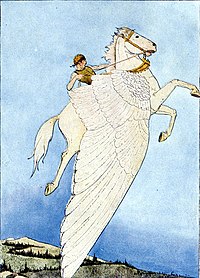 his
mother was decapitated by Perseus. Greco-Roman poets write about his ascent to
heaven after his birth and his obeisance to
Zeus, king of the gods, who instructed him to bring lightning and
thunder from Olympus. Friend of the Muses, Pegasus is the creator of
Hippocrene, the fountain on
Mt. Helicon. He was captured by the Greek hero
Bellerophon near the fountain Peirene with the
help of Athena and Poseidon. Pegasus allows the hero to ride him to defeat a
monster, the Chimera, before realizing many other exploits. His rider, however,
falls off his back trying to reach Mount Olympus. Zeus transformed him into the
constellation
Pegasus and placed him in the sky. his
mother was decapitated by Perseus. Greco-Roman poets write about his ascent to
heaven after his birth and his obeisance to
Zeus, king of the gods, who instructed him to bring lightning and
thunder from Olympus. Friend of the Muses, Pegasus is the creator of
Hippocrene, the fountain on
Mt. Helicon. He was captured by the Greek hero
Bellerophon near the fountain Peirene with the
help of Athena and Poseidon. Pegasus allows the hero to ride him to defeat a
monster, the Chimera, before realizing many other exploits. His rider, however,
falls off his back trying to reach Mount Olympus. Zeus transformed him into the
constellation
Pegasus and placed him in the sky.
Hypotheses have been proposed regarding its relationship with the
Muses, the gods
Athena,
Poseidon,
Zeus,
Apollo, and the hero
Perseus.
The symbolism of Pegasus varies with time. Symbol of wisdom and especially of
fame from the Middle Ages until the Renaissance, he became one symbol of the
poetry and the creator of sources in which the poets come to draw inspiration,
particularly in the 19th century. Pegasus is the subject of a very rich
iconography, especially through the ancient Greek pottery and paintings and
sculptures of the Renaissance. Personification of the water, solar myth, or
shaman mount, Carl Jung and his followers have seen in Pegasus a profound
symbolic esoteric in relation to the spiritual energy that allows to access to
the realm of the gods on Mount Olympus.
In the 20th and 21st century, he appeared in movies, in fantasy, in video
games and in role play, where by extension, the term Pegasus is often used to
refer to any winged horse.
Corinth, or Korinth was a
city-state
(polis) on the
Isthmus of Corinth, the narrow stretch of land that joins the
Peloponnesus to the mainland of Greece, roughly halfway between
Athens and
Sparta. The modern town of
Corinth lies
adjacent to the ancient ruins.
History
Prehistory
and founding myths
Neolithic
artifacts show that the site of Corinth had been occupied as early as the fifth
millennium BC. According to Hellenic myth, the city was founded by Corinthos, a
descendant of the god
Helios (the
Sun), while other myths suggest that it was founded by the goddess Ephyra, a
daughter of the
Titan
Oceanus, thus
the ancient name of the city (also
Ephyra). There
is evidence that the city was destroyed around 2000 BC.
Some ancient names for the place, such as Korinthos, derive from a
pre-Greek, "Pelasgian"
language; it seems likely that Corinth was also the site of a
Bronze Age
Mycenaean palace-city, like Mycenae,
Tiryns or
Pylos. According
to myth,
Sisyphus was the founder of a race of ancient kings at Corinth. It was also
in Corinth that
Jason,
the leader of the
Argonauts,
abandoned
Medea.
During the
Trojan War Corinthians participated under the leadership of
Agamemnon.
In a Corinthian myth related in the second century AD to
Pausanias
Briareus, one of the Hecatonchires, was the arbitrator in a dispute between
Poseidon
and
Helios,
between the sea and the sun: his verdict was that the
Isthmus of
Corinth belonged to Poseidon and the acropolis of Corinth (Acrocorinth) to
Helios. Thus
Greeks of the Classical age accounted for archaic cult of the sun-titan in the
highest part of the site.
The
Upper Peirene spring is located within the walls of the acropolis. "The
spring, which is behind the temple, they say was the gift of
Asopus to
Sisyphus.
The latter knew, so runs the legend, that Zeus had ravished
Aegina, the
daughter of Asopus, but refused to give information to the seeker before he had
a spring given him on the Acrocorinthus." (Pausanias, 2.5.1).
Before the end of the
Mycenaean
period the
Dorians attempted to settle in Corinth. While at first they failed, their
second attempt was successful when their leader
Aletes followed
a different path around the Corinthian Gulf from
Antirio.
Corinth
under the Bacchiadae
The Bacchiadae (Ancient Greek: Βακ�‡Î¹Î¬Î´Î±Î¹ Bakkhiadai), a tightly-knit
Doric clan
claiming descent from the Dorian
hero
Heracles through the seven sons and three daughters of a
legendary king
Bacchis, were the ruling kinship group of archaic Corinth in the eighth and
seventh centuries BC, a period of expanding Corinthian cultural power. Corinth
had been a backwater in eighth-century Greece.
In 747 BC (a traditional date) an
aristocratic revolution ousted the Bacchiad kings, when the royal clan of
Bacchiadae, numbering perhaps a couple of hundred adult males took power from
the last king, Telestes.
Practicising strict
endogamy
which kept clan outlines within a distinct extended
oikos, they
dispensed with kingship and ruled as a group, governing the city by electing
annually a
prytanis who held the kingly position
for his brief term,
no doubt a council (though none is specifically documented in the scant literary
materials) and a
polemarchos
to head the army.
In 657 BC the Bacchiadae were expelled in turn by the
tyrant
Cypselus,
who had been polemarch. The exiled Bacchiadae fled to
Corcyra but also to
Sparta and
west, traditionally to found
Syracuse in
Sicily, and to
Etruria, where Demaratus installed himself at
Tarquinia,
founding a dynasty of Etruscan kings. The royal line of the
Lynkestis
of
Macedon also claimed Bacchiad descent.
Corinth
under the tyrants
Cypselus or Kypselos (Greek:
Κ���ˆÎµÎ»Î¿�‚) was the first
tyrant of
Corinth, Greece, in the 7th century BC.
With increased wealth and more complicated trade relations and social
structures,
Greek
city-states tended to overthrow their traditional hereditary
priest-kings; Corinth, the richest archaic
polis, led
the way.
Like the
signori
of late medieval and Renaissance Italy, the
tyrants usually
seized power at the head of some popular support. Often the tyrants upheld
existing laws and customs and were highly conservative as to cult practices,
thus maintaining stability with little risk to their own personal security. As
in
Renaissance
Italy, a
cult of
personality naturally substituted for the
divine right of the former legitimate royal house.
Cypselus, the son of
Eëtion and a disfigured woman named
Labda, who was a member of the Bacchiad kin usurped the power in archaic
matriarchal right of his mother, became tyrant and expelled the Bacchiadae.

Temple of
Apollo,
Ancient Corinth.

Periander ( Πε��ίανδ��ο�‚) (r. 627– 585
BC).
According to
Herodotus
the Bacchiadae heard two prophecies from the
Delphic
oracle that the
son of
Eëtion
would overthrow their dynasty, and they planned to kill the baby once it was
born. However, Herodotus says that the newborn smiled at each of the men sent to
kill it, and none of them could go through with the plan. An etiological
myth-element, to account for the name Cypselus (cypsele, "chest")
accounted how Labda then hid the baby in a chest, and when the men had composed
themselves and returned to kill it, they could not find it. (Compare the infancy
of
Perseus.) The
ivory chest of Cypselus, richly worked with mythological narratives and
adorned with
gold,
was a votive offering at
Olympia, where
Pausanias gave it a minute description in his second century AD travel
guide.
When Cypselus had grown up, he fulfilled the prophecy. Corinth had been
involved in wars with
Argos and
Corcyra, and the Corinthians were unhappy with their rulers. At the time,
around
657 BC, Cypselus was
polemarch,
the
archon in
charge of the military, and he used his influence with the soldiery to expel the
king. He also expelled his other enemies, but allowed them to set up
colonies in
northwestern
Greece.
He also increased trade with the colonies in
Italy and
Sicily. He was
a popular ruler, and unlike many later tyrants, he did not need a bodyguard and
died a natural death.
He ruled for thirty years and was succeeded as tyrant by his son
Periander
in
627 BC. The treasury Cypselus built at
Delphi was
apparently still standing in the time of Herodotus, and the
chest of Cypselus was seen by the traveller Pausanias at Olympia in the
second century AD.
During the 7th century BC, when Corinth was ruled by the tyrants, the city
sent forth colonists to found new settlements:
Epidamnus (modern day
Durrës,
Albania),
Syracuse,
Ambracia (modern day
town of Lefkas),
Corcyra (modern day
town of Corfu)
and
Anactorium.
Periander also founded
Apollonia in Illyria (modern day
Fier, Albania) and
Potidaea
(in
Chalcidice). Corinth was also one of the nine Greek sponsor-cities to found
the colony of
Naukratis in
Ancient Egypt. Naucratis was founded to accommodate the increasing trade
volume between the Greek world and the pharaohnic Egypt, during the reign of
Pharaoh
Psammetichus I of the
26th dynasty.
Classical
Corinth
In
classical times, Corinth rivaled
Athens and
Thebes in wealth, based on the Isthmian traffic and trade. Until the mid-6th
century Corinth was a major exporter of
black-figure pottery to cities around the Greek world. Athenian potters
later came to dominate the market. It was once believed that Corinth housed a
great temple on its ancient
acropolis
dedicated to the goddess
Aphrodite;
yet excavations of the temples of Aphrodite in Corinth reveal them to be small
in stature.
Despite the mythical story from Strabo of there being more than one thousand
temple prostitutes employed at the Temple of Aphrodite, this was likely not
accurate as the story rests on a misunderstanding.
Corinth was also the host of the
Isthmian Games.
Periander
was considered one of the
Seven Wise Men of Greece. During his reign the first Corinthian
coins
were struck. He was the first to attempt to cut across the Isthmus to create a
seaway to allow ship traffic between the Corinthian and the Saronic Gulf. He
abandoned the venture due to the extreme technical difficulties he met, but he
created the
Diolkos (a stone-build overland ramp) instead. The era of the Cypselids,
ending with Periander's nephew
Psammetichus, named after the hellenophile Egyptian Pharaoh Psammetichus I
(see above), was the golden age of the city of Corinth.
During this era Corinthians developed the
Corinthian order,
the third order of the classical architecture after the
Ionic
and the Doric. The
Corinthian order was the most complicated of the three, showing the accumulation
of wealth and the luxurious lifestyle in the ancient city-state, while the Doric
order was analogous to the strict and simplistic lifestyle of the older Dorians
like the Spartans, and the Ionic was a balance between those two following the
philosophy of harmony of Ionians like the Athenians.
Horace is quoted as saying: "non licet omnibus adire Corinthum", which
translates as "Not everyone is able to go to Corinth",
due to the expensive living standards that prevailed in the city. The city was
renowned for the temple prostitutes of
Aphrodite,
the goddess of love, who served the wealthy merchants and the powerful officials
living in or traveling in and out of the city. The most famous of them,
Lais, was said to have extraordinary abilities and charged tremendous fees
for her favours.
The city had two main ports, one in the Corinthian Gulf and one in the
Saronic Gulf, serving the trade routes of the western and eastern
Mediterranean, respectively. In the Corinthian Gulf lay
Lechaion,
which connected the city to its western colonies (Greek:
apoikoiai) and
Magna
Graecia, while in the Saronic Gulf the port of
Kenchreai
served the ships coming from Athens,
Ionia,
Cyprus and the
rest of the
Levant.
Both ports had docks for the large war fleet of the city-state.
The city was a major participant in the
Persian Wars, offering forty war ships in the sea
Battle of Salamis under the admiral
Adeimantos and 5,000
hoplites (wearing their characteristic
Corinthian helmets) in the following
Battle of Plataea but afterwards was frequently an enemy of Athens and an
ally of
Sparta
in the
Peloponnesian League. In
431 BC, one of
the factors leading to the
Peloponnesian War was the dispute between Corinth and Athens over the
Corinthian colony of Corcyra (Corfu), which probably stemmed from the
traditional trade rivalry between the two cities.
After the end of the Peloponnesian War, Corinth and Thebes, which were former
allies with Sparta in the Peloponnesian League, had grown dissatisfied with the
hegemony of Sparta and started the
Corinthian War
against it, which further weakened the
city-states of
the Peloponnese. This weakness allowed for the subsequent invasion of the
Macedonians of the north and the forging of the
Corinthian League by
Philip
II of Macedon against the
Persian Empire.
In the
4th
century BC, Corinth was home to
Diogenes of
Sinope, one of the world's best known
cynics.
Later
history
In the
3rd
century BC, Corinth was a member of the
Achaean League,
and was completely destroyed by the Roman general
Lucius Mummius in
146 BC.
While there is archeological evidence of some minimal habitation in the years
afterwards,
Julius Caesar refounded the city as Colonia laus Iulia Corinthiensis
in 44 BC shortly before his assassination. According to
Appian, the new settlers were drawn from
freedmen of Rome.[citation
needed]
The
city and its environs
Acrocorinth,
the acropolis
Main article:
AcrocorinthAcrocorinthis, the
acropolis
of ancient Corinth, is a monolithic rock that was continuously occupied from
archaic times to the early nineteenth century. The city's archaic acropolis,
already an easily defensible position due to its geomorphology, was further
heavily fortified during the
Byzantine Empire
as it became the seat of the
strategos
of the
Thema of Hellas. Later it was a fortress of the Franks after the
Fourth Crusade, the Venetians and the Ottoman Turks. With its secure water
supply, Acrocorinth's
fortress was used as the last line of defense in southern Greece because it
commanded the
isthmus of
Corinth, repelling foes from entry into the Peloponnesian peninsula. Three
circuit walls formed the man-made defense of the hill. The highest peak on the
site was home to a
temple to
Aphrodite which was
Christianized as a church, and then became a
mosque. The
American School began excavations on it in 1929. Currently, Acrocorinth is one
of the most important medieval castle sites of
Greece.
The
city
The
two ports: Lechaeum and Cenchreae
Corinth had two harbours:
Lechaeum on the
Corinthian Gulf and
Cenchreae on the
Saronic
Gulf. Lechaeum was the principal port, connected to the city with a set of
long
walls of ca. 2 miles length, and was the main trading station for Italy and
Sicily, where there were many Corinthian colonies, while Cenchreae served the
commerce with the Eastern Mediterranean. Ships could be transported between the
two harbours by means of the
diolkos
constructed by the tyrant
Periander.
Biblical
Corinth
Corinth is mentioned in the New Testament in the epistles of Corinthians 1
and 2. Under the Romans, Corinth became the seat of government for Southern
Greece or
Achaia (according to
Acts 18:12-26). It was noted for its wealth, and for the luxurious,
immoral and vicious habits of the people. It had a large mixed population of
Romans, Greeks, and
Jews.
When the apostle
Paul first
visited the city (AD 51 or 52),
Gallio, the brother of
Seneca, was
proconsul.
Paul resided here for eighteen months (see
Acts
18:1-18). Here he first became acquainted with
Aquila and
Priscilla,
and soon after his departure
Apollos came
from
Ephesus.
Paul visited Corinth for a "second benefit" (see
2 Corinthians 1:15), and remained for three months, according to
Acts
20:3. During this second visit, believed to have occurred in the spring of 58,
it is likely that the
Epistle to the Romans was written.
Based on clues within the Corinthian epistles themselves scholars have
concluded that Paul wrote possibly as many as four
epistles to
the church at
Corinth.
Only two of them,
the 1st Epistle to the Corinthians and
the 2nd Epistle to the Corinthians are contained with the
Canon of Holy
Scripture. The first Epistle reflects the difficulties of maintaining a
Christian community in such a cosmopolitan city. The second reaffirms the love
Paul has for this young church and his hopes for their continued growth. |
